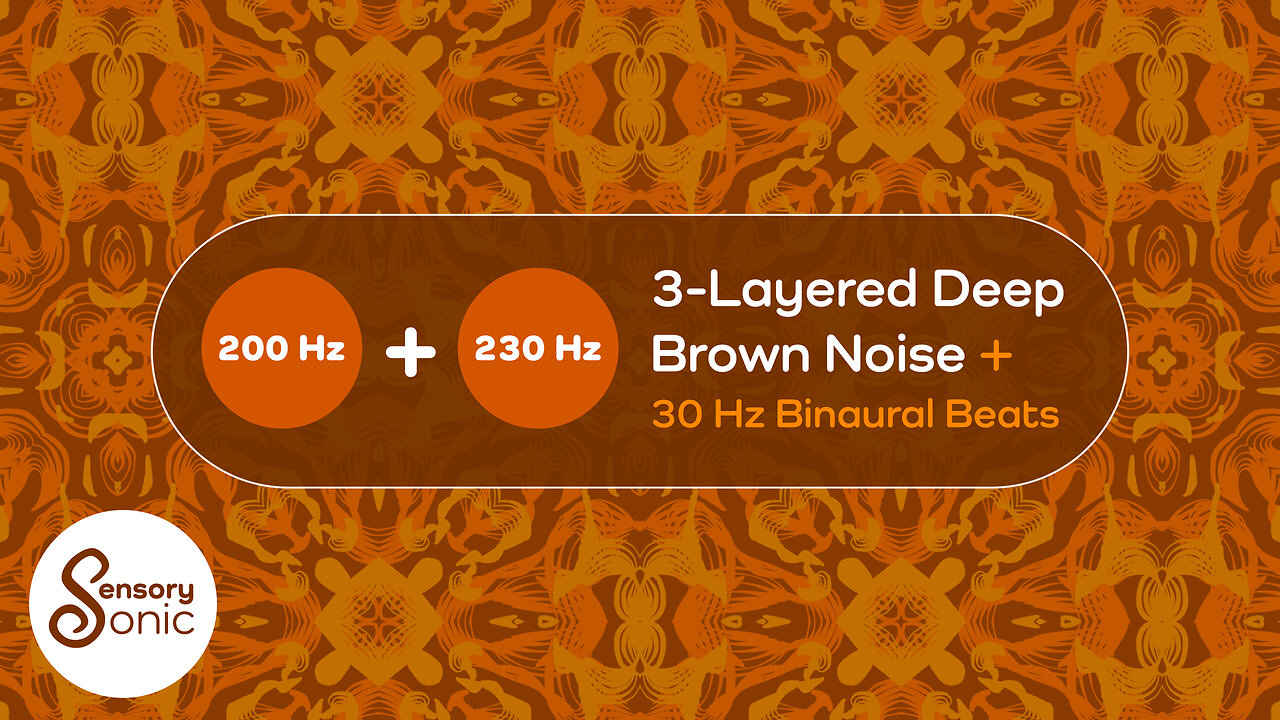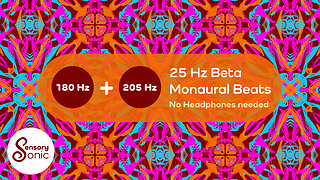Premium Only Content

30 Hz Binaural Beats With Multi-Layered Deep Brown Noise | Mask Noise and Boost Concentration
I've combined 30 Hz binaural beats with multi-layered brown noise to make a noise masking and concentration enhancing background sound. Made using 200 Hz + 230 Hz, 30 Hz is the borderline between beta and gamma which both enhance attention, focus and thinking skills.
#brownnoise #binauralbeats #brownnoisemeditation #brownnoisestudying #rednoise #30hz #gamma #beta #brainwaveentrainment #brainpower
---
Brown noise, also known as Brownian noise or red noise, is a type of random signal where the energy decreases as the frequency increases. It has a spectral density that decreases by 6 dB per octave (or 20 dB per decade). As a result, brown noise has more energy in the lower frequencies, which can be perceived as a deeper, smoother sound. It is often likened to the sound of a gentle waterfall or rolling thunder.
---
Binaural beats are a form of auditory illusion created by playing a slightly different frequency in each ear using headphones. When the brain processes these two frequencies, it perceives a third tone, known as the binaural beat, which has a frequency equal to the difference between the two input frequencies. This perceived beat is not actually present in the external environment but is a creation of the brain's processing.
The underlying principle behind binaural beats is called "brainwave entrainment." It suggests that the brain's electrical activity can be synchronized or entrained to external rhythmic stimuli, such as sound frequencies. Various frequencies of binaural beats correspond to different mental states, ranging from relaxation to focus and even deep meditation.
The benefits of binaural beats can vary from person to person. Some potential benefits reported by individuals include:
Relaxation and stress reduction: Binaural beats in the lower frequency range, such as delta (0.5-4 Hz) and theta (4-8 Hz), are associated with deep relaxation and can help reduce stress and anxiety.
Improved focus and concentration: Binaural beats in the alpha (8-13 Hz) and beta (13-30 Hz) ranges may enhance alertness, concentration, and cognitive performance. They may help with studying or for tasks requiring mental focus.
Sleep enhancement: Binaural beats in the delta range can promote sleep and reduce insomnia by helping to induce a state of deep relaxation and facilitating the transition into sleep.
Mood enhancement: Binaural beats may have mood-altering effects, promoting positivity, tranquility, or even euphoria.
It's important to note that scientific research on the effectiveness of binaural beats still needs to be expanded. While some studies suggest positive effects, the individual response to binaural beats can also vary, and some people may be more receptive than others.
Binaural beats are generally considered safe for most individuals when used correctly. However, there are a few considerations:
Potential discomfort: Some individuals may find certain frequencies or volume levels of binaural beats uncomfortable or irritating. Always listen at a comfortable volume.
Epilepsy and seizures: People with a history of epilepsy or seizures should exercise caution, as flashing lights or rapid auditory stimuli can trigger seizures in sensitive individuals.
Dizziness or lightheadedness: Occasionally, binaural beats may induce mild dizziness or lightheadedness in some individuals.
Remember that binaural beats should not replace medical treatment or professional advice for any health condition.
-
 1:30:03
1:30:03
Sensory Sonic
11 months ago25 Hz Beta Monaural Beats | 90 Minutes | No Headphones Needed | Boost Focus, Attention And Thinking
317 -
 LIVE
LIVE
Mally_Mouse
1 hour agoLet's Yap About It - LIVE!
335 watching -
 LIVE
LIVE
Film Threat
7 hours agoJUSTINE BATEMAN SPEAKS! LIVE INTERVIEW | Hollywood on the Rocks
166 watching -
 4:02
4:02
Guns & Gadgets 2nd Amendment News
49 minutes agoBREAKING NEWS: FBI Director RESIGNS
114 -
 LIVE
LIVE
Dr David Jockers
42 minutes agoHow High Blood Sugar Destroys Your Arteries & How To Fix It
58 watching -
 LIVE
LIVE
StoneMountain64
2 hours ago1st person FORTNITE is here.
304 watching -
 1:46:40
1:46:40
The Pat Bev Podcast with Rone
5 hours agoWhat's Wrong the the Eastern Conference & How Do the Lakers Save Their Season? Ep. 113
3.51K -
 2:57:20
2:57:20
The Charlie Kirk Show
4 hours agoNo, Caitlin Clark, Noooo! + The Confirmation Odds + AMA | Pirro, Hilton, Halperin | 12.11.24
127K38 -
 1:36:13
1:36:13
The Quartering
3 hours agoBrett Cooper QUITS Daily Wire, Alex Jones WINS Lawsuits, White People Bad & More
49.6K26 -
 1:05:11
1:05:11
Russell Brand
4 hours agoPandemic 2.0? The Promise of Disease X - SF512
111K135